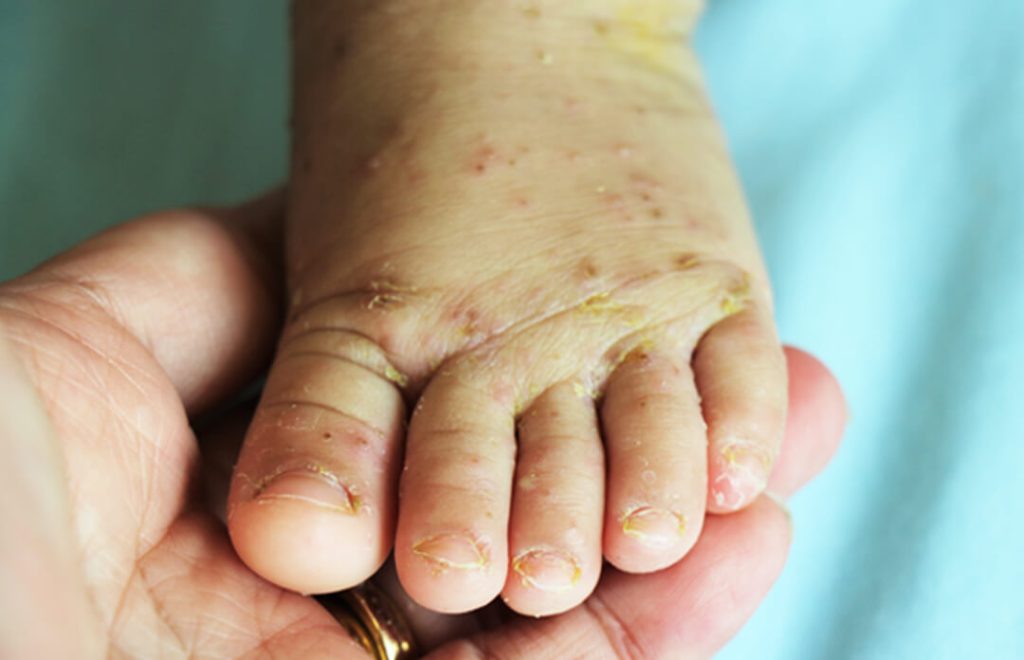
Skin conditions can often be confusing, especially when symptoms seem similar. Hand, Foot & Mouth Disease and impetigo are two such conditions that often get mixed up due to their overlapping symptoms. However, they are distinct illnesses requiring different approaches. Let’s dive into their differences, symptoms, and treatments.
Are Impetigo and Hand-Foot-Mouth the Same?
No, impetigo and Hand, Foot, and Mouth Disease are not the same, though both can appear as skin issues. Here are the key distinctions:
Cause
Impetigo is a bacterial infection caused by Staphylococcus aureus or Streptococcus pyogenes. Hand, Foot, and Mouth Disease is a viral illness, most often caused by the Coxsackievirus.
Age Group
Impetigo is common in children but can also affect adults, particularly if their skin is injured or irritated. Hand, Foot, and Mouth Disease primarily occurs in children under five but occasionally affects older children and adults.
Contagion
Both are highly contagious. Impetigo spreads through direct contact with infected skin or surfaces, while Hand, Foot, and Mouth Disease spreads through respiratory droplets, saliva, or contact with contaminated objects.
Appearance
Impetigo starts as small red sores that turn into honey-coloured crusts, usually around the mouth and nose. Hand, Foot, and Mouth Disease appears as red spots or blisters on the hands, feet, and inside the mouth.
What Does Impetigo Look Like When It Starts?
Impetigo often begins as small, red, itchy sores on the skin. These sores quickly develop into blisters that ooze and form a distinctive yellow or honey-coloured crust.
- Common Locations: Around the mouth and nose, though it can spread to other parts of the body.
- Symptoms: Itchiness, mild discomfort, and in some cases, swollen lymph nodes.
If left untreated, impetigo can spread rapidly, especially in children who tend to scratch the affected areas. Early diagnosis and treatment for impetigo are crucial to prevent complications.
What are the Symptoms of Hand, Foot, and Mouth Disease?
Hand, Foot, and Mouth Disease presents differently:
- Fever and Fatigue: Often the first signs before the rash appears.
- Mouth Ulcers: Painful sores on the tongue, gums, and inside of the cheeks.
- Skin Rash: Red spots or blisters on the palms, soles, and sometimes the buttocks.
Hand, Foot, and Mouth Disease is typically mild and resolves on its own within a week, but its sores can cause discomfort, especially during eating or drinking.
Treatment for Impetigo
If you suspect impetigo, it’s important to consult an expert. Here’s how it’s treated:
- Topical Antibiotics: Creams or ointments like fusidic acid are often prescribed to clear the infection.
- Oral Antibiotics: In more severe cases, doctors may prescribe oral antibiotics.
- Hygiene Measures: Washing the affected area with mild soap and water helps prevent spreading.
- Avoid Scratching: Keeping nails short and covering sores with loose clothing can help reduce transmission.
If you are living in areas like East Burnham, Gerrards Cross, or Stoke Poges and are seeking impetigo treatment, you can conveniently book an appointment at Aroga Pharmacy in Farnham Common for expert care.
How to Manage Hand, Foot, and Mouth Disease?
Hand, Foot, and Mouth Disease usually doesn’t require specific treatment and can be managed with home care:
- Hydration: Ensure plenty of fluids to avoid dehydration.
- Pain Relief: Over-the-counter medications like paracetamol can help reduce fever and pain.
- Rest: Allow the body to recover fully.
Say Goodbye to Skin Worries Today!
Living around East Burnham, Gerrards Cross, or Stoke Poges? Don’t let skin infections like impetigo linger. Book an appointment at Aroga Pharmacy in Farnham Common for reliable treatment and advice. Whether it’s identifying symptoms, providing effective remedies, or guiding you to healthier skin, Aroga Pharmacy is here to help.
Act now for expert care—because your skin deserves the best!
